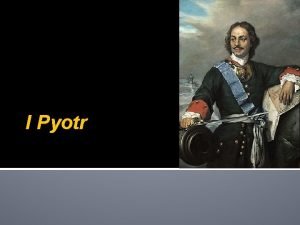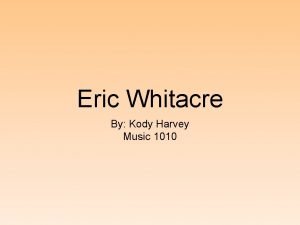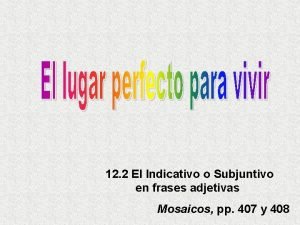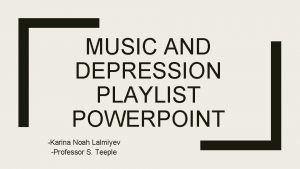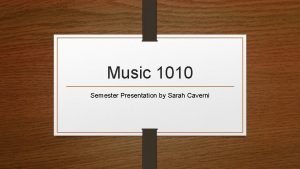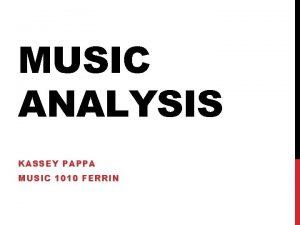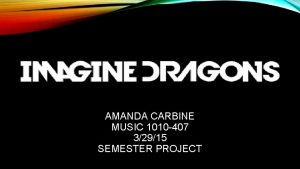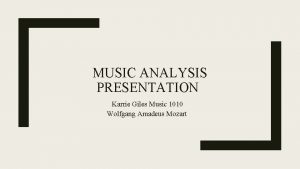MUSIC ANALYSIS POWERPOINT PRESENTATION MUSIC 1010 407 PYOTR









- Slides: 9

MUSIC ANALYSIS POWERPOINT PRESENTATION MUSIC 1010 -407 PYOTR ILLYICH TCHAIKOVSKY 1840 -1893

PYOTR ILLYICH TCHAIKOVSKY WAS BORN 7 MAY, 1840 AND GREW UP IN VOTKINSK, RUSSIA IN WHAT IS TODAY PART OF THE UDMURT REPUBLIC OF THE RUSSIAN FEDERATION. THE SECOND CHILD OF A METAL WORKER, ILLYA PETROVITCH AND A FRENCH MOTHER, ALEKSANDRA ANDREYEVNA. HE WAS INTRODUCED TO MUSIC AT AN EARLY AGE AND WAS EDUCATED AT THE IMPERIAL SCHOOL OF JURISPRUDENCE IN ST. PETERSBURG WHERE HE WAS TRAINED TO BECOME A CIVIL SERVANT.

TCHAIKOVSKY ATTENDED BOTH THE ST. PETERSBURG CONSERVATORY AND THE MOSCOW CONSERVATORY AS A STUDENT, IN THE LATER WHERE HE COMPOSED SEVERAL OF HIS FIRST PIECES, ONE OF WHICH, SWAN LAKE WAS TO BECOME A WORLD-RENOWNED WORKS.

IN HIS LIFETIME HE WAS KNOWN TO HAVE BEEN MARRIED TO, IF NOT INVOLVED WITH THREE RELATIONSHIPS: 1. ) DÉSIRÉE ARTÔT IN 1869; 2. ) ANTONINA IVANOVNA MILIUKOVA IN 1877 WHICH WAS PROPOSED BY TCHAIKOVSKY; 3. ) NADEZHDA VON MECK.

TCHAIKOVSKY IS REMEMBERED IN LARGE FOR HIS MOST FAMOUS WORKS, MANY OF WHICH ARE STILL PREFORMED SEASONALLY TODAY: EUGENE ONEGIN, SLEEPING BEAUTY; THE NUTCRACKER SUITE, 1812 OVERTURE

PYOTR ILLYICH TCHAIKOVSKY DIED ON 6 NOVEMBER, 1893 ONLY 9 DAYS AFTER PERFORMING HIS LAST PIECE, HIS SIXTH SYMPHONY, PATHETIQUE, IN ST. PETERSBURG. HE WAS INTERRED AT TIKHVIN CEMETERY, ALEKSANDER NEVSKY MONASTERY, STILL LEGALLY A MARRIED MAN. IT WOULD BE HIS FAMOUS PIECES OF MUSIC THAT WOULD LEAVE HIM TO BECOME A LEGEND WELL AFTER HIS DEATH.

COMPOSITION • 1812 Overture by Pyotr Illyich Tchaikovsky • Written in 1880 • Composed between October-November of that year • Commissioned by the Cathedral of Christ the Savior • For Russia’s victory over the French in 1812 • Borodino and Moscow • Said to have bee Tchaikovsky’s “noisy, ” piece

OVERTURE 1812

LISTENING GUIDE: TCHAIKOVSKY’S 1812 OVERTURE • 0: 00 -01: 08 is the intro, hymn, “God Save the Tsar, ” by vocal. This is also the simple triple • 01: 08 -03: 12: crescendo into the strings and bass instruments • 03: 12 -03: 40: the beginnings of the French horn, trombones (this is the upper and middle portio of the brass), this portion of the music is the Russian victory over the French that leads into the French National Anthem of, “La Marseillaise. ” • 03: 41: string instruments along with brass, violins, violas, cellos and double basses; who perform the melody. • 04: 40: is a variation of La Marseillaise from the strings, violins, violas, double bass and cello • 05: 03: the brass section: trombone, French horns, trumpets with violins • 05: 40: leads into a decent • 05: 57: is the first section of the piece with the strings and also the woodwinds • 6: 40 hear the oboe, English horn who has a counter melody • 7: 00 -7: 06 the melody is continued by that of the flutes • 7: 21 until 7: 26 is the bassoon keeps the time as the French National Anthem is played • 08: 05 you have the tubas • 10: 18 – 11: 10 is the timpani • 11: 10 – 12: 23 Chorus; the Russian Orthodox hymn with trumpets on the melody, with 1 and 2 octaves up, all in unison above the melody that is played by the brass • 12: 16 the strings with bells • 12: 23 – 16: 00 Cannons, strings finish
